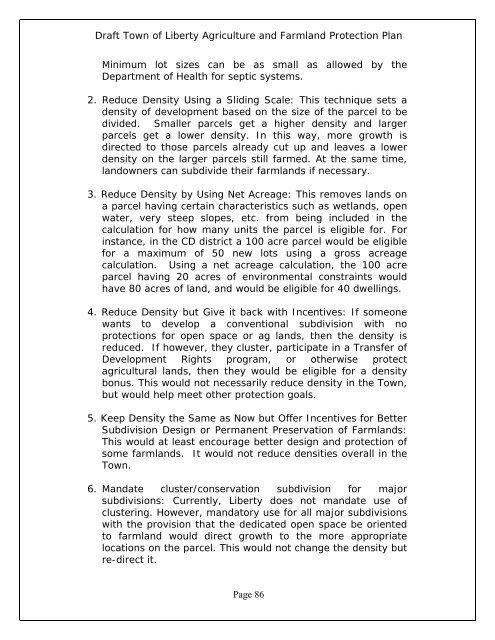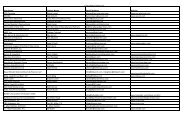Agriculture and Farmland Protection Plan - Town of Liberty
Agriculture and Farmland Protection Plan - Town of Liberty
Agriculture and Farmland Protection Plan - Town of Liberty
Create successful ePaper yourself
Turn your PDF publications into a flip-book with our unique Google optimized e-Paper software.
Draft <strong>Town</strong> <strong>of</strong> <strong>Liberty</strong> <strong>Agriculture</strong> <strong>and</strong> Farml<strong>and</strong> <strong>Protection</strong> <strong>Plan</strong><br />
Minimum lot sizes can be as small as allowed by the<br />
Department <strong>of</strong> Health for septic systems.<br />
2. Reduce Density Using a Sliding Scale: This technique sets a<br />
density <strong>of</strong> development based on the size <strong>of</strong> the parcel to be<br />
divided. Smaller parcels get a higher density <strong>and</strong> larger<br />
parcels get a lower density. In this way, more growth is<br />
directed to those parcels already cut up <strong>and</strong> leaves a lower<br />
density on the larger parcels still farmed. At the same time,<br />
l<strong>and</strong>owners can subdivide their farml<strong>and</strong>s if necessary.<br />
3. Reduce Density by Using Net Acreage: This removes l<strong>and</strong>s on<br />
a parcel having certain characteristics such as wetl<strong>and</strong>s, open<br />
water, very steep slopes, etc. from being included in the<br />
calculation for how many units the parcel is eligible for. For<br />
instance, in the CD district a 100 acre parcel would be eligible<br />
for a maximum <strong>of</strong> 50 new lots using a gross acreage<br />
calculation. Using a net acreage calculation, the 100 acre<br />
parcel having 20 acres <strong>of</strong> environmental constraints would<br />
have 80 acres <strong>of</strong> l<strong>and</strong>, <strong>and</strong> would be eligible for 40 dwellings.<br />
4. Reduce Density but Give it back with Incentives: If someone<br />
wants to develop a conventional subdivision with no<br />
protections for open space or ag l<strong>and</strong>s, then the density is<br />
reduced. If however, they cluster, participate in a Transfer <strong>of</strong><br />
Development Rights program, or otherwise protect<br />
agricultural l<strong>and</strong>s, then they would be eligible for a density<br />
bonus. This would not necessarily reduce density in the <strong>Town</strong>,<br />
but would help meet other protection goals.<br />
5. Keep Density the Same as Now but Offer Incentives for Better<br />
Subdivision Design or Permanent Preservation <strong>of</strong> Farml<strong>and</strong>s:<br />
This would at least encourage better design <strong>and</strong> protection <strong>of</strong><br />
some farml<strong>and</strong>s. It would not reduce densities overall in the<br />
<strong>Town</strong>.<br />
6. M<strong>and</strong>ate cluster/conservation subdivision for major<br />
subdivisions: Currently, <strong>Liberty</strong> does not m<strong>and</strong>ate use <strong>of</strong><br />
clustering. However, m<strong>and</strong>atory use for all major subdivisions<br />
with the provision that the dedicated open space be oriented<br />
to farml<strong>and</strong> would direct growth to the more appropriate<br />
locations on the parcel. This would not change the density but<br />
re-direct it.<br />
Page 86




